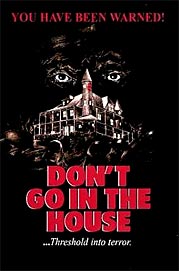
DON'T GO IN THE HOUSE
(1980,US)



"YOU HAVE BEEN WARNED!
... Threshold into terror."
directed by: Joseph Ellison
starring: Dan Grimaldi, Robert Osth, Ruth Dardick, Charles Bonet, Bill
Ricci, Dennis Hunt, John Hedberg, Johanna Brushay, Darcy Shean, Mary Ann Chin,
Lois Verkimeps, Susan Smith, Jim Donnegan, Claudia Folts, Denise Woods
choice dialogue:
“Don't make me do anything bad, Mother!”
- Danny channels Norman Bates.
[review by Justin Kerswell]
Grim is the only word for Joseph Ellison's psychological terror movie. Perhaps
not a slasher flick in the truest sense, DON'T GO IN THE HOUSE
ticks enough boxes – and is plenty disturbing enough – to warrant
inclusion on this website. If you are after the safe popcorn chills of FRIDAY
THE 13TH (1980) forget it, this tale of madness and the progeny of
child abuse is an altogether darker proposition.

Danny Kohler (effectively played by the SOPRANO's Dan Grimaldi)
is a seriously fucked up young man. Years of abuse by a domineering mother –
including burning his arms over a naked flame when he was a child – have
left him only functioning in the most basic way. Even seeing one of his work
mates at the waste incineration plant consumed by flames after an accident fails
to raise him from his stupor, and he merely watches. One of his other colleagues,
Bobby (Robert Osth), tries to befriend him, but the others call him a “sicko”
and “crazy”. He escapes their catcalls and returns to his
now elderly mother, who he finds has died in her sleep. At first he's distraught,
but then begins hearing voices telling him, “We can help you. You're
free now. You can do anything you want to do!”. At first his new
found freedom is relatively harmless, and he bounces on the furniture and plays
his disco records as loud as he wants to.

However, Danny continues to hear his mother's voice telling him he's bad. He
skips work and keeps her death a secret. He then begins to build a flame proof
room, putting metal sheets on the walls and hanging a hook from the ceiling.
Under the false pretension of giving a kindly florist a lift home he tricks
her into the house whilst he tends to his 'sick' mother. When she attempts to
phone for a taxi he knocks her out. She comes to in his makeshift room, hanging
naked from the ceiling. Danny enters wearing one of the flame retardant suits
from the incinerator and carrying a flame-thrower. He pours petrol on her, set
her alights and watches as she burns to death ...
The effects are horribly convincing in this scene, an unflinching camera shows
the naked woman writing in agony as the flames engulf her. This is still strong
stuff. Even in this day and age where films such as HOSTEL
(2005) and SAW (2004) have supposedly pushed the boundaries
of what is acceptable on screen, it is difficult to imagine a scene this graphic
being shown in a mainstream horror movie today. Whilst the rest of the film
is nowhere near as graphic, it sets the relentlessly misanthropic tone of what
is to follow.

It is also certainly this scene which marked the film out for prosecution during
the video nasties hysteria of the early 80s. Its chances were probably not helped
by the typically lurid British video artwork of the time, which had the tagline:
“In a steel room built for revenge they die burning ... in chains.”
Coincidentally, the film was filmed under the title THE BURNING,
but that had already been nabbed by another future nasty-to-be.
The influences on DON'T GO IN THE HOUSE are pretty clear:
PSYCHO (1960), DERANGED (1974) and THE
TEXAS CHAIN SAW MASSACRE (1974). All of them based on the infamous
Ed Gein case. However, whilst those films tempered the horror with varying degrees
of comic relief, Joseph Ellison's film remains poker faced throughout. Despite
featuring a scene where a dancer is set alight by a table candle at a disco,
it is remarkable that it never really crosses the line into cheesiness. Given
that the film is so influenced by others, it is interesting to note that it
seems to have done some influencing of its own. Donny's state of mind further
deteriorates when he hallucinates (or does he?) his mother and his charred victims
coming back to life to take their revenge on him – it's a scene that may
have been reworked in William Lustig's contemporary slasher MANIAC
(1980).

The freezing winter, when the film is set, not only emphasises the emotional
wasteland of the Kohler household, but also provides a potent juxtaposition
to the fiery deaths of Danny's victims. None of the victims have much of a back
story, but are simply attractive pawns in the actions of a madman. The cyclical
ending, which once again reaffirms the film's central premise that the abuse
of a child by his mother leads to psychotic behaviour might make you think that
the film is misogynistic at its (very black) heart. However, the film's producer
and co-writer is a woman.
It's easy to forget just how nihilistic much of American genre cinema was as
the 70s turned into the 80s (especially with the avalanche of cheese that was
just round the corner), but DON'T GO INTO THE HOUSE is a chilly
reminder of times when practically anything went.
BODYCOUNT 5  female:4 / male:1
female:4 / male:1
1)
Female found dead
2) Female burnt to death
3) Female burnt to death
4) Female burnt to death
5) Male burnt to death







 female:4 / male:1
female:4 / male:1